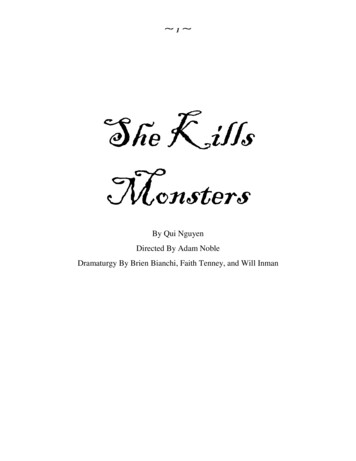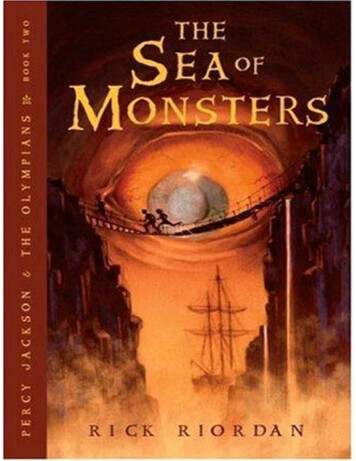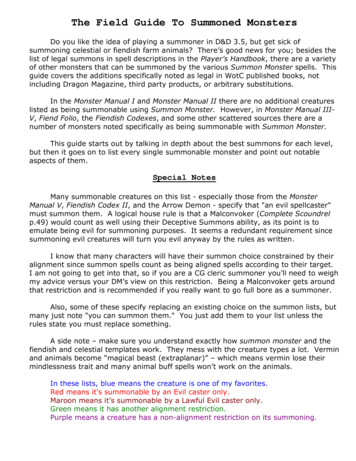
Transcription
1 She KillsMonstersBy Qui NguyenDirected By Adam NobleDramaturgy By Brien Bianchi, Faith Tenney, and Will Inman
2 Table of Contents:About the Play: 3Qui Nguyen: Playwright : 5State of the Gay: Gay Culture in the 90s: 7Bestiary: 10Character Alignments; Where do you fall?: 22
3 About the Play:Gary Gygax and his partners made their first release of Dungeons and Dragons in January1974, as a means to provide tools to young and emerging game-makers with which to create a gameand world all their own. That’s all that this game is, really - a bunch of rules and tools that dependentirely upon the imaginations and creativity of the players and Dungeon. As such, there is adefinite aspect of wish fulfillment involved in the playing of this game and its descendants. Imaginethe archetypical geek character, often small and weak, often clumsy, or unable to engage in athleticand “cool” activities. Within a game of D&D they might become eight-foot-tall barbarians, alienlizard people, or wizards whose lack of physical might is made up for by their ability to channel thepower of their mind into physical forces of ice and fire. In the 42 years since its release the gamehas grown to suit the needs of a wide range of tastes. Expansions have been provided to takegamers outside of the realm of fantasy and into Outer Space, The Wild West, Post-ApocalypticWastelands, Steam-Punk Landscapes, and more.In the world of our play, Agnes gets to be reunited with her sister, Tilly enjoys a position inthe majority instead of being marginalized as a geek, and Kelly is able to execute amazing acrobaticprowess. Characters fly through the air, fire off magical spells, and find love in a world where theymake the rules (but must still follow them). This gives rise the idea of escapism; the fleeing, if onlybriefly, from the struggles that each of us face in our daily lives in the “real” world. Many who havebeen identified as “geeks” are scorned for this behavior and apparent lack of ability to functionwithin the world into which they were born. J.R.R. Tolkien, in response to such attitudes, wrote inhis essay On Faerie Stories that, “Why should a man be scorned, if, finding himself in prison, hetries to get out and go home? Or if, when he cannot do so, he thinks and talks about other topics
4 than jailers and prison-walls?” He further talks of the restorative aspects of escapist behavior.How, through such activities of reading fantasy literature, playing games (both video and table-top),and imagining, one can restore themselves enough to return to the fight of daily real life. With theissues that the human race faces today such as racism, homophobia, illness, and hate, is it anywonder that there are those who would choose to seek out or create worlds in which they arepowerful enough to make a difference and/or where opposition can always be overcome bywhatever it is that they bring to the table.
5 Qui Nguyen: PlaywrightQui Nguyen (pronounced “Kwee Gwen”) was bornin El Dorado, Arkansas on January 1st, 1976. He is aplaywright, screenwriter, and an overall pioneer of “geekculture.” He and his most frequent collaborators, directorRobert Ross Parker and designer Nick Francone foundedthe theatre company Vampire Cowboys in 2000 right outof graduate school. The OBIE award winning companydescribes itself as a, “geek theatre” company that createsand produces new works of theatre based inaction/adventure and dark comedy with a comic bookaesthetic. The company actively pursues the mating ofdifferent genres with varied theatrical styles to create aneclectic structure to tell its stories. The company aims tobridge the gap between mass media entertainment and theperforming arts, exposing the community to challenging,thought-provoking live entertainment rooted in today’spop-culture vernacular.” Each of the founders used their own skills to create something that hadnot been prevalent on the stage: “ninjas, kung-fu, girl fights,” as Nguyen explained it to The NewYork Observer in 2012. However, the Vampire Cowboys spent their first few years putting ontheatre that generally went unnoticed. That changed when Abby Marcus, now Qui Nguyen’s wife,first saw a production at Vampire Cowboys in 2007 and became determined to find them anaudience. She quickly arranged for them to perform a choreographed fight from their upcomingsuperhero play Men of Steel. After that, they began to draw in a fiercely loyal crowd. Apart fromthe company’s devotion to geek culture, many of its shows strive to feature women in empoweredroles in which are figured in roles often considered to be masculine such as super heroes, fantasywarriors, and ninjas.Stage violence has always been close to Nguyen’s heart.Many of his graduate school teachers discouraged himfrom putting fight scenes on the stage, arguing thatviolence was best fit for film. This only fueled his drive toput action onstage. “I don’t think Shakespeare sat aroundand complained, ‘Well, I want to put in a sword fight,but that’s really a film technique,’” Nguyen said in thesame interview with The New York Observer, “In filmyou’re constrained by realism, but I can just have fivepuppets and some smoke and it becomes a dragon.” Hespent five years in New York as a fight director, thenthree years teaching stage combat at Columbia before he and his wife moved to Minneapolis in2010.His scripts include:Vietgone (South Coast Rep, Oregon Shakespeare Company, Manhattan Theatre Club)She Kills Monsters (The Flea, Buzz Chicago/Steppenwolf, Company One)
6 War is Fucking Awesome (developed in the Sundance Theatre Lab)Krunk Fu Battle Battle (East West Players)Bike Wreck (Ensemble Studio Theatre)Trial By Water (Ma-Yi Theater)Aliens Versus Cheerleaders (Keen Teens)Soul SamuraiThe Inexplicable Redemption of Agent G (Ma-Yi Theater & Vampire Cowboys)and the plays produced by his own Vampire Cowboys:Alice in SlasherlandFight Girl Battle WorldMen of SteelLiving Dead in Denmark.
7 “State of the Gay”: Gay culture in the 90’s2016 is a wonderful time to be gay. Same-sexmarriage has been legalized, there are gay celebritieseverywhere you look, and there are informative, safegay youth programs all over the country. If it feels likeacceptance of homosexuality is skyrocketing, the 90’swas when it was beginning to crest.Before understanding being a gay, early 90’steen on a personal level, we’ll look at the facts. Therewas quite a lot of political progress going on in thisperiod. In 1990: the Federal Hate Crimes Statistics Actis passed- the first federal recognition of homosexuals.In this year Dale McCormick also became the firstopenly lesbian senator.In 1991: the first Pride celebration happened in Harrisburg, Pennsylvania. It was calledthe Unity Festival. 1993 gave us our first Dyke March in Washington, D.C.That same year, Bill Clinton instituted “Don’t Ask, Don’t Tell”. Although by currentstandards this measure is draconic and discriminatory, by the standards of 1993 it wasprogressive and divisive. Before the policy was enacted, homosexuals were sniffed out and
8 dishonorably discharged from service. BillClinton announced that sex was none of thegovernment’s business, which was a ballsymove and important to the LGBTmovement.1994 also had the American MedicalAssociation opposing the “treatment” ofhomosexuality. Conversion therapy, as itwas called, was a method of exposingsame-sex oriented people (often teenagers)to members of the opposite sex until theirhomosexuality was “cured”. A flat denialfrom the AMA of homosexuality as adisease was a huge win for the gaycommunity.As we edge closer to Tillie’sexperience, we move into the world ofpopular culture. The first lesbian kiss ontelevision was between Amanda Donohoe and Michele Greene on L.A. Law in 1991. It wasundoubtedly a publicity stunt, but that fact hardly registered with the lesbian teens across thecountry who were exposed to it.Grammy-winner Melissa Etheridge came out in 1993 at the Triangle Ball, which was alsothe first inaugural ball held in honor of gays and lesbians.Perhaps most importantly was Pedro Zamora of The Real WorldSan Francisco. The first positively-portrayed AIDs-positive manon television, he continued to do educational works for gay teensuntil his death in 1995.This leads us to the individual experience of the gayteenager. Today, when we think of gay issues, we think ofmarriage equality. In the early 90’s, homosexuality wasimmediately associated with violence and AIDs. In 2016, gayyouth worry about bullying while their families worry aboutthem not fitting in. In the 90’s, gay youth worried about beatingswhile their families worried about a terminal illness.Perhaps the hardest idea for modern teenagers tounderstand is the fear gay youth experienced in that time period.Sure, there is a little anxiety about coming out nowadays, butwith all of the programs and online assistance available, it ishardly a life-threatening concern. While all of the things listedabove make the 90’s seem like a gay paradise, it’s important to
9 keep in mind that those things were only happening at the top, while the normal towns in theflyover states were still being faced with a rock-solid wall of opposition. A 1992 Newsweek pollfound that 45% of those asked considered gay rights "a threat to the American family and itsvalues". The average American still needed quite a bit of convincing.While Bill Clinton, Ellen DeGeneres, and Will & Grace might have been a source ofcourage, coming out in high school was still nigh-unthinkable. Escaping to a fantasy world ofacceptance might have been the only thing that made sense.
10 BestiaryShe Kills Monsters involves the character of Agnes Evans engaging in an elaborate D&Dcampaign designed by her late sister Tilly. As every good scout knows, it’s best to be prepared,a lesson that Agnes will need to learn the hard way before the play is through. A given party ofadventurers can encounter any of a number of creatures throughout their quest, from AssassinVines to Zombies. Game creators Gary Gygax and his company, TSR, have published severalvolumes called Monster Manuals filled with creatures for Dungeon Masters to fill the halls of theirdungeons with in order to challenge the bold and punish the unwary adventurer. Knowing thestrengths and weaknesses of your foes can often be the key to success in battle. Here are includedjust a few of the creatures that Agnes and Tilly might need to battle during the course of the play.Beholder:One glance at a beholder is enough toassess its foul and otherworldly nature. Abeholder’s spheroid body is covered inchitinous plates, scales, or leathery flesh. Itsgreat bulging eye sits above a wide, toothy maw,while the smaller eyestalks that crown its bodytwist and turn to keep its foes in sight. Abeholder channels extraordinary levels ofmagical power. Its central eye emits a broadfield of energy that can nullify the magic of itsfoes, while its eye stalks blast those foes with ahost of powerful effects. A beholder’s centrallair is typically large, spacious cavern with highceilings, where it can attack without fear ofclosing to melee range. Some beholdersmanage to channel their pervasive xenophobictendencies into a terrible despotism. Rather than live in isolation to avoid other creatures, theaptly named eye tyrants enslave those other creatures, founding and controlling vast evilempires. An eye tyrant sometimes carves out a domain within or under a major city,commanding networks of agents that operate on their master’s behalf.
11 Bug-Bear: Bugbears resemblehairy, feral goblins standing seven feet tall. Theytake their name from their noses and claws,which are similar to those of bears. Bugbearsoften armor and arm themselves with a variety ofgear purloined from fallen enemies. Most often,this gear is second-rate and in poor repair.Bugbear eyes are greenish white with redpupils, and their wedge-shaped ears rise from thetops of their heads. Most bugbears have hidesranging from light yellow to yellow brown andtheir thick, coarse hair ranges from brown tobrick red. The bugbears of the Land of Black Iceare known to have blue fur.Bugbears have exceptional sight and hearing,able to see in pitch darkness. They move withamazing stealth.Dark-Elf:The Drow are an undergrounddwelling sub-race of Elves easilyrecognized by their obsidian skin,pale hair, and usually red eyes. Theyare almost always neutral evil innature. Elves are closely tied to therealm of Faerie, or Feywild in D&D,it is this relationship that accounts fortheir aloof nature, though they areknown to be curious in nature whilein their youth. While their closenessto the Feywild makes themparticularly adept magic users, theyare also capable of becoming gracefulwarriors.
12 DemonLord:Also known as Abyssallords, these arearchfiends who gainedgreat power andestablished a position ofpreeminence amongdemon-kind. Eachdemon lord had a uniqueappearance and set ofabilities. Most controlledat least one layer of theAbyss. A demon lord,when slain in a planeother than the Abyss, wasbanished to the Abyss fora hundred years, whereasordinary demons riskedbeing reborn into a lesserform, or not all. Ademon lord who had complete control over an entire layer of the abyss was known as a demonprince. Demon lord and demon prince were self-proclaimed titles; unlike the archdevils, thechaotic evil demon lords did not have a rigidhierarchy.Demon lords waged eternal war with eachother, often seeking ways to expand theirholdings into other layers and at the same timedefend their personal domains from rival lordsand scheming underlings. Demogorgon had, formany years, been the most powerful demonlord, and proclaimed himself Prince of Demons- a coveted status symbol since the Age beforeAges granted by the Abyss itself to the mostpowerful, ruthless, cunning demon in the plane.Miska the Wolf Spider was the first to hold it,followed by Obox-ob, and now Demogorgon.Orcus and Graz'zt contested this title, whileObox-ob desires to regain it.
13 Demon Queen:Numerous accounts inFolklore speak of Lilith asthe first Demon Queen.Initially created as the firstwife of Adam (of JudeoChristian fame) out of thesame Earth as herhusband. When sherefused to submit toAdam’s dominance on thegrounds that they hadbeen equally created fromthe same materials, sheabandoned Adam and isrecorded to have insteadtaken up with the demonking Asmodeus. Therebybecoming not only the firstdemon queen, but also themother of the Nephilim,earthly celestial beings thatare said to have interbredwith humans to create a race of giants and were part of the reasoning behind God’s flooding theEarth.Lilith is thereby viewed as a symbol of not only female independence, but of female sexualityand the feminine power to procreate.Lilith is also connected with the Succubi, likely in relation to her position as a being inpossession of her own sexual power and identity, but she is also noted to be a devourer of infants.
14 Doppelganger: Doppelgangers are strange beings that are able to take on theshapes of those they encounter. In its natural form, the creature looks more or less humanoid, butslender and frail, with gangly limbs and half-formed features. The flesh is pale and hairless. Itslarge, bulging eyes are yellow with slitted pupils. A doppelganger’s appearance is deceiving evenwhen it’s in its true form. A doppelganger is hardy, with a natural agility not in keeping with its frailappearance.Doppelgangers make excellent use of theirnatural mimicry to stage ambushes, bait traps, andinfiltrate humanoid society. Although not usuallyevil, they are interested only in themselves andregard all others as playthings to be manipulatedand deceived.In its natural form a doppelganger is about 5½feet tall and weighs about 150 pounds.Elves:“Elf” serves an over-arching term for a large number of differing nearly immortal, slender,pointy-eared, sylvan humanoids. From the ethereal High-Elves (Sub-sects of which are the Sunand Moon elves), the wild and playful wood-elves, the noble and arrogant Grey-Elves, and thehateful and reclusive Drow, each variant has its own cultural rules, stigmas, and qualities.Official D&D materials have this to say regarding them,
15 They are more often amused than excited, and more likely to be curious than greedy. Theytend to remain aloof and unfazed by petty happenstance. When pursuing a goal, however,whether adventuring on a mission or learning a new skill or art, elves can be focused andrelentless. They are slow to make friends and enemies, and even slower to forget them.They reply to petty insults with disdain and to serious insults with vengeance.Elves take up adventuring out of wanderlust. Since they are so long-lived, they canenjoy centuries of exploration and discovery. They dislike the pace of human society,which is both regimented from day to day but constantly changes over decades, so they findcareers that let them travel freely and set their own pace. Elves also enjoy exercising theirmartial prowess or gaining greater magical power, and adventuring allows them to do so.Some might join with rebels fighting against oppression, and others might becomechampions of just causes.The High-elves, with their closeness to the Feywild have learned the ability to phase out ofthe “Prime” world, as they call it, and pass through the Fey to reappear in another place in thePrime. Thus creating a variant on a teleport ability.Drow, having survived in the harsh underdark for so long, have acquired the ability to seein near total darkness as well as spell-like abilities to either surround a target in a soft “Faerie Light”to prevent concealment or to in a cloud of darkness to conceal a target as well as making themharder to hit with attacks.
16 Wood-Elves are more heavily built than their brethren, and approach magic and its userswith a certain level of distrust. They favor the ranger class and are most at home in their forestrealm homes.Fairy:“What care I for human hearts? Soft and spiritless as porridge. A faerie’s heart beats fierce andfree You Mortal, you! I could Vex You!”Do not make the mistake of confusing theFairy with classically beautiful, diminutive creaturesof modern children’s entertainment who go aboutgranting wishes and aiding fair maidens in findingtheir prince. The pixie, which is the closestapproximation to the physical description given byfairy tales, is a spiteful and mischievous creature whois more likely to lead you off a cliff in a fog just forthe fun of it, than to grant you a wish. J.M Barriecomments that most faeries are so small that theycan only hold one emotion at a time, therefore anangry faerie will only know anger at that moment, orjealously, or spite.Shakespeare imagined these creatures ruled by the Demi-gods Titantia and Oberon, whoseinfluence over nature was so potent that without meaning to, they upset the natural forces simplyby not sharing a marriage bed. Also mentioned in Shakespeare, and throughout folklore, is theruling power of Queen Mab, who is at times regarded as a faerie herself, and at others as a darkpagan goddess who rules over the realm of the Fey (also commonly referred to as Faerie).These creatures are mostly chaotic neutral, choosing to do what interests them most at anygiven moment. As such they can often appear child-like in both attitude and appearance. Helpingone person while hindering the other, and often times both behaviors are done just because theybelieve it to be fun or entertaining.Modern high fantasy fiction has also brought into the mind of the reader/player theconcept of the summer and winter courts of the Fae, but this has little bearing on our endeavorsand need only be delved into if desired. What is best to keep in mind is that the Faerie is wild,fickle, and above all, free.
17 GelatinousCube: The gelatinous cube isendowed with an insatiable hunger.These creatures scour dungeonpassages, consuming living tissue whileleaving bones and other materialsundissolved.Creatures that fall victim to agelatinous cube rarely see it coming. Itsprotoplasmic form is all buttransparent. By the time a creaturemakes contact with an unseen cube, itis too late to run. A cube that is well fedcan be easier to spot, since its victims’bones, coins, and other objects can be seen suspended inside the creature.Kobold: Kobolds inhabit dragons’lairs when they can but more commonly infestdungeons, gathering treasures and trinkets to addto their own tiny hoards.As egg-laying creatures, the kobolds’ birthrate is higher than any other humanoid race.They mature quickly, and can live to be “greatwyrms” more than a century old. Despite theabundant numbers of their young, many koboldsperish before they reach the end of their firstdecade. Physically weak, they are easy prey forcompetent predators in the dark and dangerousrealms where they reside. This vulnerabilityunderlies their cowardice and forces them toband together. Their superior numbers can winbattles against powerful adversaries, but often withmassive casualties on the kobold side.Kobolds make up for their physical ineptitudewith a cleverness for trap making and tunneling.Their lairs consist of low tunnels through which
18 they move easily, but which make it difficult for larger humanoids to maneuver. Rather than facethe claws, teeth, and blades of their enemies head-on, kobolds riddle their lairs with rock falls, nets,concealed pits, and other traps designed to eliminate or ensnare their foes before they get close.These lairs are efficient and orderly places where the strong rule over the weak, whether bycompetence or cruelty.Lich: A lich is an undeadspellcaster, usually a wizard or sorcererbut sometimes a cleric or otherspellcaster, who has used its magicalpowers to unnaturally extend its life.A lich is a gaunt and skeletalhumanoid with withered flesh stretchedtight across horribly visible bones. Itseyes have long ago been lost to decay, butbright pinpoints of crimson light burn onin the empty sockets.An integral part of becoming a lich iscreating a magic phylactery in which thecharacter stores its life force. As a rule,the only way to get rid of a lich for sure isto destroy its phylactery. Unless itsphylactery is located and destroyed, a lichreappears 1d10 days after its apparentdeath.
19 Mind Flayers:Based on the titular creature of H.P.Lovecraft’s Call of Cthulu, the mind flayer, alsocalled Illithid, is a parasitic creature that devoursthe brain of its host and assumes control overthe body. The octopus-like head has fourtentacles with which is penetrates the skull of itsvictims to remove the brain. The Illithid sharea consciousness that is focused on the hiveleader call the elder brain.Mind flayers most potent weapon is avariety of psionic powers, but some sects havebeen known to dabble in the arcane arts,making wizard their favored class.Most share a tall and slim physiology, andare relatively weak in physical combat, althoughthey possess a tough, leathery skin.OGRE: Ogres appeared as gianthumanoids with very muscular bodies andlarge heads. They stood between 9 and 10 feettall and could weigh 600 to 650 lbs. Theytended to be lazy and brutish, preferring to relyon ambush and overwhelming numbers inbattle. Ogres often worked as mercenaries,hoping for easy plunder.
20 Succubus: Vampiric femaledemons who are known to attack men asthey sleep. In folklore they are alwaysconnected with the sexual, in fact,folklore attributes them as beingresponsible for wet dreams; coming to aman in his sleep and causing him to spillhis seed while unconscious. Lilith, thewife of Asmodeus the demon lord, isheld to have been among the firstsuccubus. What is important to noteregarding the succubus is her portrayal asa vampiric character, while not alwayssanguine (blood seeking) the succubusmust always feed upon the energy ofothers. Whether they are drinkers of lifegiving blood, energy, life-force, or even aperson’s soul they are always in search ofthat which enlivens, or animates theirvictims. In D&D they avoid battle,preferring to turn foes on each other, andmanipulate them.Their male equivalent is theincubus, who were used in folklore toexplain mysterious pregnancies.
21 Tiamat: The Queen of Evil Dragons is a five-headed dragon of enormous size. Eachof her five heads matches that of a chromatic dragon, and each head has its own brain and its ownintelligence. The five heads do not argue, and they all share the same goals. The only goal ofimmediate interest to Tiamat is finding a way to escape imprisonment in the Nine Hells.Tiamat is the patron goddess of chromatic dragons and the embodiment of greed andenvy. She takes the form of a five-headed dragon, and each head is a different color. She gave birthto the five primary species of chromatic dragon, each taking the form of one of her heads. Tiamatcombines the powers of all of the chromatic dragons. Confined to the Nine Hells by the power ofthe greater gods, Tiamat longs to escape and wreak havoc upon the world.
22 Character Alignments: Where DoYou Fall?:While the rules of Dungeons and Dragons provide a great deal of freedom in how acharacter is played and makes decisions, the choice of alignment is vital in informing how acharacter will react in a given situation, or how a creature or NPC (non-player-character) will actbased on the actions of the players. When making her D&D character in the play, Agnes is askedwhat her alignment is. Below is a listing of the nine basic alignments chosen by players during theirpre-game character creation. Based on this information, what alignment are you?Lawful Good: A lawful good character typically acts withcompassion and always with honor and a sense of duty. Suchcharacters include righteous knights, paladins, and mostdwarves. Lawful good creatures include the noble goldendragons.Neutral Good: Aneutral good charactertypically actsaltruistically, withoutregard for or againstlawful precepts such as rules or tradition. A neutral goodcharacter has no problems with co-operating with lawfulofficials, but does not feel beholden to them. In the eventthat doing the right thing requires the bending or breakingof rules, they do not suffer the same inner conflict that alawful good character would.Chaotic Good: A chaotic good character does what's necessaryto bring about change for the better, disdains bureaucraticorganizations that get in the way of social improvement, andplaces a high value on personal freedom, not only for oneself,but for others as well. Chaotic good characters usually intend todo the right thing, but their methods are generally disorganizedand often out of sync with the rest of society.
23 Lawful Neutral: A lawful neutral character typicallybelieves strongly in lawful concepts such as honor,order, rules, and tradition, and often follows apersonal code. Examples of lawful neutral charactersinclude a soldier who always follows orders, a judgeor enforcer that adheres mercilessly to the word of thelaw, and a disciplined monk.Neutral: A neutral character (a.k.a. true neutral) isneutral on both axes and tends not to feel stronglytowards any alignment, or actively seeks their balance.Druids frequently follow this dedication to balance,and under Advanced Dungeons & Dragons rules, wererequired to be this alignment. In an example given inthe 2nd Edition Player's Handbook, a typical druidmight fight against a band of marauding gnolls, onlyto switch sides to save the gnolls' clan from beingtotally exterminated.Chaotic Neutral: A chaotic neutral character is anindividualist who follows their own heart andgenerally shirks rules and traditions. Although chaoticneutral characters promote the ideals of freedom, it istheir own freedom that comes first; good and evilcome second to their need to be free.
24 Lawful Evil: A lawful evil character sees a wellordered system as being easier to exploit and shows acombination of desirable and undesirable traits.Examples of this alignment include tyrants, devils,and undiscriminating mercenary types who have astrict code of conduct.Neutral Evil: A neutral evil character is typicallyselfish and has no qualms about turning on its alliesof-the-moment, and usually makes allies primarily tofurther their own goals. A neutral evil character hasno compunctions about harming others to get whatthey want, but neither will they go out of their way tocause carnage or mayhem when they see no directbenefit for themselves. Another valid interpretation ofneutral evil holds up evil as an ideal, doing evil forevil's sake and trying to spread its influence.Examples of the first type are an assassin who haslittle regard for formal laws but does not needlessly kill, a henchman who plots behind theirsuperior's back, or a mercenary who switches sides if made a better offer. An example of thesecond type would be a masked killer who strikes only for the sake of causing fear anddistrust in the community.Chaotic Evil: A chaotic evil character tends to haveno respect for rules, other people's lives, or anythingbut their own desires, which are typically selfish andcruel. They set a high value on personal freedom, butdo not have much regard for the lives or freedom ofother people. Chaotic evil characters do not work wellin groups because they resent being given orders anddo not usually behave themselves unless there is noalternative
His scripts include: Vietgone (South Coast Rep, Oregon Shakespeare Company, Manhattan Theatre Club) She Kills Monsters (The Flea, Buzz Chicago/Steppenwolf, Company One) . She Kills Monsters involves the character of Agnes Evans engaging in an elaborate D&D campaign designed by her late sister Tilly. As every good scout knows, it's best to .









![Your Rights In Christ [Revised] - Yola](/img/31/07-20your-20rights-20in-20christ.jpg)
